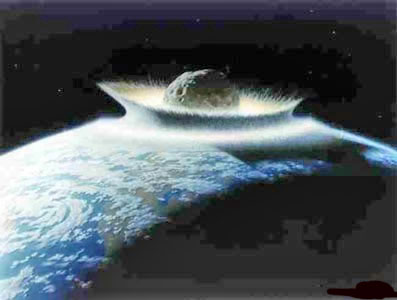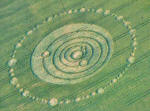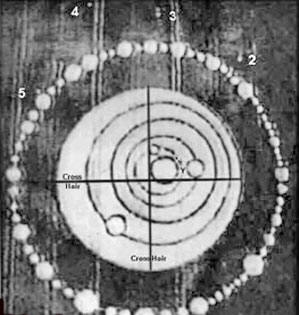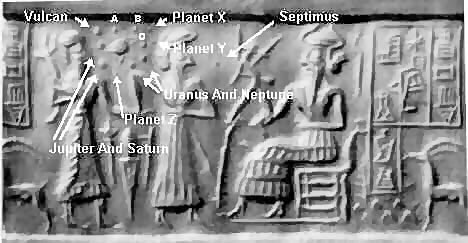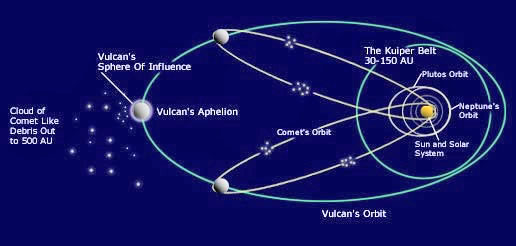|
|
|
by Barry M. Warmkessel, Ph.D.
2004 from ParanoiaMagazine Website
Vulcan is the distant, yet to be observed, dark star companion of the Sun.
It has flavored our
collective culture, sparked religious wars, aided in the
manifestation of avatars like Christ and Buddha1 and stimulated
quasi-periodic bombardment of Earth by comet strikes, redirecting
the course of human civilization.
Our research paper entitled "Earth's Bleak Future" 2 estimates that Vulcan orbits the Sun in slightly less than 5,000 years in a very eccentric orbit that is highly inclined to the ecliptic plane.
It is anticipated to be a Jovian-sized Protostar (called Vulcan by the Theosophists) 141 to 165 times Earth's mass, black or red in color and dense like Earth.
Vulcan is very faint, about magnitude 21, comparable to the objects investigated by IRAS analysts.3
We initially determined Vulcan's orbit with the aid of the Tzu Wei, a form of Chinese astrology, as well as other physical data.4
Interestingly, Professor George Forbes arrived at a value of 5000 years for the period of an undetected planet in 1880. He used the aphelion (the point farthest from the Sun) of multiple long-period comets to predict an undiscovered planetary orbit similar to Vulcan's orbit in terms of period, inclination and node.
It is important to note that the Vulcan Team does not suggest
that the dark star comes anywhere near the inner solar system but,
rather, it casts comets from the Kuiper Belt into near Earth orbits.
Vulcan never gets closer to the Sun than about 2.7 times as far as
Pluto's farthest point.
We find that four (or more)
comet swarms have formed at two distant (444 AU) locations separated
by 13 degrees in Vulcan's elliptical orbit. (AU=Astronomical Unit,
Sun to Earth)
Sir Fred Hoyle, Britain's recently deceased royal astronomer, postulated that meteor strikes averaging 10,000 years apart are responsible for initiating and terminating Ice Ages. Warm interglacial intervals, lasting about 10,000 years, are found interspersed in the Ice Ages.
This interval
is loosely related to comet impacts when Vulcan is near aphelion;
specifically, it is related to both the location of Vulcan and the
periodicity of the Vulcan-induced comet swarms.
The combined analysis indicates that Vulcan's period is between 4969
(theoretical) and 4992 (geo-climatological) years. These procedures
can also be used to approximately estimate when threatening comet
swarms may next appear.
Biblical sources (Matthew 24:21, Revelation 6:12-17, 8:5-13,
16:17-21 and 18:8-10,21 etc.) suggest that a smaller comet will
impact a 'thousand years' (Revelation 20:1-6) before the final
event.
At most, a five-month visual warning is anticipated.
Crop Circle T367 - A Current Warning
This, combined with the localization
of a threatening comet swarm by debris detection gear (postulated to
be used by ET spaceships), would permit them to precisely know when
the Earth would be at risk from a comet impact.7
The "small white spots" (four objects, one broken in two, totaling five) called "grapeshot" are depictions of meteors or comets. The "missing" Earth (its orbit is still depicted) signifies its devastation by the anticipated strikes.
The relative locations of the planets and the
precise location of their perihelion
This crop circle has another unusual feature: the Sun and planets are off-center. In our analysis, the center of the circle is defined by the cross hairs added to the crop circle image.
The misalignment between the centroid and the Sun is presumed caused by the Sun-Vulcan center of mass.
Assuming this circle defines the barycenter (center of mass) of the Sun-Vulcan binary system, it is
offset toward IRAS 1732+239, an astronomical object that could be
Vulcan.
Here, all the Hebrew letters found in a book in the Bible are strung without word or page breaks and rastered in 64 columns. A computer is used to search for words in a horizontal, vertical or diagonal format.
Skip sequence words are searched (every other row or column is skipped) and viable words are found.
Many skip codes exist, like 4, 10, 50, etc. Words cross other words or are found in the matrix vicinity of other words. It is postulated that these word groups are related.
Even the name given to the Sun's dark star companion (Vulcan) is specifically mentioned in the Bible Code:
A variety of events are also revealed, including victories and defeats of political figures, assassinations, atomic holocausts, earthquakes and comet/asteroid strikes.
President Clinton's election and the unexpected victory of Prime Minister Netanyahu were predicted. The "kicking out of a President" due to "Watergate" was revealed. Details of the assassinations of Yitzhak Rabin, Netanyahu (delayed), President Kennedy and R. F. Kennedy were found.
Great earthquakes found in the Bible Code include the 1906 San Francisco quake, the 1976 China quake, the 1994 Los Angeles quake and the 1995 Kobe Japan quake.
Earthquakes predicted include a 2010 Los Angeles quake, a Japan
quake expected in 2000 and/or 2006, and a 2013 quake at an
unspecified location.
The Bible Code predicts that the Swift-Tuttle comet will re-appear in 2126, but will miss Earth because it "comes in the seventh month."
In fact, the International Astronomical Union had issued a low-key
warning of a potential collision between Swift-Tuttle and Earth
based on its 2126 return. This warning was rescinded when new data
indicated it would safely pass in late July, not mid-August as was
first estimated.
Alexander Tollmann9 dates seven impacts to approximately 7910 and 7810 BC, when the celestial geometries between Vulcan and the Sun were much like they are now.
This configuration moves the inner
solar system farthest from the Sun-Vulcan barycenter. The
theoretically projected impact dates are 2028 and 2128, with seven
double-sourced predictions of impacts or near misses occurring
about:
2006-7,
2011-13, 2015-16, 2030-31, 2044-45, 2071 and 2120-30.
The T367 crop circle image shown here is believed to
suggest the range and the date when the next threatening comet swarm
first becomes visible, but it could also indicate when Earth
(India?) may be hit.
The Bible Code predicts that this comet will be crumbled as it passes around the Sun, as was the SL9 comet as it passed Jupiter. Many of SL9's fragments made spots on Jupiter larger than the Earth. One of the comets (#3 shown in Crop Circle T367) is a double, and perhaps has already been crumbled.
Alternately, it may be crumbled in Earth's atmosphere. Another comet may cause tsunamis and fiery hail before and after its fragments strike the Mediterranean basin. One, according to Nostradamus, strikes the Aegean Sea off Evvoia destroying ancient Greek and Roman structures in the month of October shortly after the new millennium.
This event is predicted for approximately 2015-2016.
The shock of its passage through the atmosphere could produce large quantities of (sour) nitric acid, poisoning lakes and streams.
The Israel meteorite seems
to be one of about "super-tanker" size. A 500-meter fragment would
make an impact site about a hundred miles wide. Israel would be
thrice annihilated: by direct strike, tsunamis, and starvation
(Isaiah 13:12 and Daniel 2:24-45).
It is believed that this impact will set off the Yellowstone super-volcano.
Other impacts may follow, with coinciding predictions
of 2120-2130, but humankind may be devastated by then.
Forbes predicted a planet with orbital parameters similar to those of Vulcan's. He also predicted a planet at 87-122 AU with a 1,076-year orbit. In his 1994 book, ASTRO-METRICS, Yari Danjo1 predicted a planet he called Septimus at 154 AU.
Perhaps the same planet, Danjo
considered Septimus to be spawned by interaction between the Sun and
Vulcan. His analysis indicated that Septimus is Earth-sized.
Astronomer Clyde Tombaugh searched for these planets and concluded
that none existed brighter than magnitude 16.5.
The IRAS search
found three unknown objects but two may have been later identified
(as gas clouds, galactic objects, etc.). (Nature, May 1984) Which
two was not specified, but Vulcan is believed to be at or near one
of these three: IRAS object 1732+239.
The IRAS was placed in orbit in 1982, after
Sir Fred
Hoyle proposed in 1981 that meteor impacts cause Ice Ages.
Surprisingly, he failed to consider that a distant planet in a
highly elliptical orbit could cause frequent bombardment of Earth.
An unpublished case occurred on 6 October 1974, when an individual was invited to board an ET craft and seemed to know a little of astronomical symbols. He was not mesmerized, but remained lucid during the event and prepared a report afterwards.
Contained
was an example of the ET's interpretation of our alphabet and a
description of the solar system that included our Sun's companion
star.11
In The 12th Planet, Zecharia Sitchin displays a clay cylinder seal (VA/243) from the Akkadian civilization of Mesopotamia 4,500 years ago, showing globes of various sizes orbiting the Sun. What makes the Akkadian Seal so unique is that the sizes are given. There are three small planets representing Mercury, Venus and Mars (Earth and Moon are not shown).
Shown are the Jovian planets with their diameters in scale to the logarithm of their known masses.
Uranus and Neptune are depicted along with three larger planets, two of which represent Jupiter and Saturn. We interpret the more distant large planet to represent the dark star, Vulcan.
Logarithms were unknown to the ancients, therefore, this data could only have come from an ET source.
The mass depicted for Vulcan is consistent with the T367 Crop Circle barycenter and the quasi-periodic impact intervals found in Earth's geo-climatological history.
Sitchin anticipates an object called Marduk in an elongated elliptical orbit reaching from deep space to the inner planets.
Its 3,600-year period is close to our comet swarm's 3,313-year average period. We think the Babylonians knew of two comet clusters (within a comet swarm) and named them Marduk (a.k.a. Phaeton) and Tiamat. Marduk was recorded as a major astronomical entity with four "attendants" (five total, as depicted in Crop Circle T367) and Tiamat with eleven or more.
An apparent "battle" occurred as Tiamat rounded the Sun and met incoming Marduk. A major comet, Kingu, is also shown. People living near Ardmarnoch in western Scotland may have seen this event about 10,000 years ago.
They carved its (or Tiamat's) image on a large flat rock. Twenty-two
comet-like objects are arranged in a cluster as if a comet had
fragmented while passing around the Sun.
Huge hills of sub-fossilized and carbonized wood indicate that one strike was in the Arctic Ocean between Siberia and Alaska. The fragments may have reached the Carolinas.
However, this may have been the result of an
earlier strike that formed the Carolina bays and also left a large
impact crater on the ocean floor near Bermuda.
Normally, the oceans act as a gigantic heat engine, forming water vapor that moves north and south with the winds. When it rains or snows, heat is released, warming the mid-latitudes.
Stony meteorites are five to ten times more common than metal ones.
A meteorite more than 300 meters in size would throw a thousand times its mass into the high atmosphere. Half-micron sized debris could remain aloft for over ten years, causing the oceans to cool and lose their reserves of heat.
Fine ice
crystals, which naturally form when temperatures drop below minus 40º C, would no longer be held at bay by heat rising from the
Earth. They would reflect much of the Sun's radiation back into
space causing the Earth to remain suspended in an Ice Age.
Such an impact could be responsible for the extinction of 32 genera of mega fauna around 11,600 years ago at the end of the Ice Age.
The rapid
thaw melted the permafrost turning their tundra into a huge bog.
This is why these giant mammals (e.g. wooly mammoths) are found
buried upright. Well fed, they sank as the ground beneath them
flooded and thawed.
Geologists agree that glacial periods last about 100,000 years, whereas both interglacial periods and periodic fluctuations of temperature within the glacial period (bringing about the advance and retreat of glacial ice) each last about 10,000 years.
NASA's David Morrison
notes that the chance that civilization may sustain a serious meteor
strike could be as high as 1 in 10,000. Some pre-historians think
our current warm age will not last much longer.
Curiously, Hoyle takes pains to extricate his theory from Noah's flood. He misdates it to 5,000 BC rather than to 3,000 BC, as do most theological sources. Hoyle also claims, without basis, that a cave (not an Ark) was involved.
Hoyle's downplaying / dismissal of Noah's Ark is very curious, especially since it was found circa 1948 and investigated in the 1980s by Fasold, Windsor and Wyatt.12
Was Hoyle apprised of a secret program, since he was the "ace" astronomer of the UK?
Geologists
cited in a book he references recorded a mini Ice Age about 5,300
years ago, near the anticipated date of the strike causing a
worldwide flood. We think the Great Flood occurred 3195 BC based on
matching theological and tree ring data.
Earth's magnetic field is currently diminishing and there is mounting evidence of increased aurora activity at lower latitudes. We think the magnetic field changes are related to Vulcan's aphelion and perihelion.
They are
"cemented in" by comet impacts.13
This must have proven nearly as disastrous for humans as for the mega fauna that were driven to extinction. Reversals of the Earth's magnetic field when Vulcan is near aphelion could cause penetration of high-energy ions from the Van Allen belts.
These
would produce biological mutations, new strains of bacteria and
viruses, and the combined effects of chemical, nuclear and
biological warfare.
The most popular topic in ancient legends is the deluge, but in many the deluge occurs after a conflagration or firestorm. When mentioned in pairs, the firestorm precedes the deluge, and the water extinguishes it. Also mentioned is ice hail, rains of blood and solid material (like stones), as well as tsunamis and boiling lakes and rivers.
The
average date of this event, derived from all sources, is 11,581
years ago.
Bone breccias are often strongly ferruginous and silicified.
This material may have come from the debris field, or the main body of the comet itself, or both. A metal core comet striking the Earth would inject large amounts of metal dust into the stratosphere, creating a "sky of brass" and turning the icy tundra into a muddy swamp.
These legends
support Fred Hoyle's theory that a metal meteorite caused the great
mega fauna extinction circa 11,600 years ago.
The Koran states that the wave bearing the Ark
united with other waters from more southern latitudes.
All ET-related material is assumed not to be a hoax. The only measure of reasonability of "pseudo-science" data is its link to accepted data.
Vulcan is linked to valid scientific data like the Akkadian seal, the IRAS search for a Protostar and the resulting IRAS object. It is also found in "pseudo-scientific" data like Betty Hill's star map, Crop Circle T367 and an unpublished ET description of the solar system.
Vulcan's orbit was (partially) derived by Chinese astrological techniques, so it is considered a "pseudo-science" result. But it is linked to Forbes' hypothetical planet's orbit and geo-climatological data, both deduced by standard scientific methods.
The comet's revisit cycle is linked to Vulcan's
5,000-year period and to the 10,000-year long interglacial periods
(by a 3:2 orbit resonance). While the precise threatening impact
dates are "pseudo-scientific" data, they fit within the
mathematically projected window of a past impact event.
Given our leaders' deceptive nature, only the chosen elite will survive the impending impacts, thus eliminating the technological base required to impede the later threats.
Human beings could end up viewing a "New Heaven and New
Earth" (2 Peter 3:13 and Revelation 21) after incarnating in a new
body type in a different solar system.
References
|


